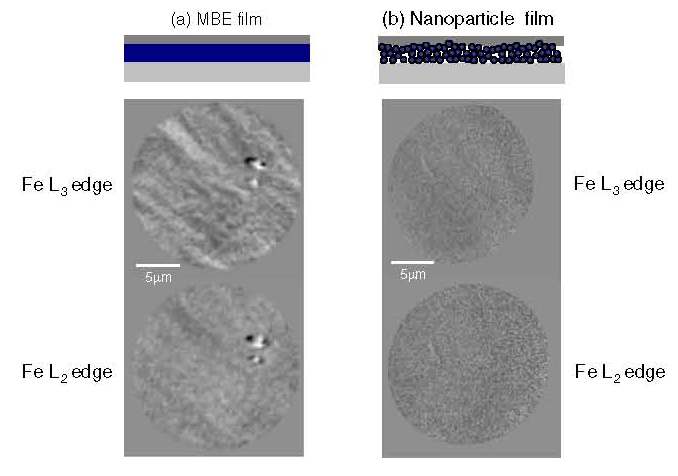Thin films produced by depositing pre-formed size-selected gas-phase nanoparticles are an important class of materials, particularly because of their application in magnetic memory. A team led by Chris Binns at the University of Leicester worked with the team on the Nanoscience beamline to study the magnetic properties of Fe thin films produced by this technique and compared them to Fe thin films produced by conventional techniques. Their results have been published in the Journal of Physics: Condensed Matter.
In detail
 |
| Figure 1 (a) XPEEM images at the Fe L3 and L2 edges of the domain structure in a 200 °A thick MBE-grown film on Si(111). (b) Similar XPEEM image from the cluster-assembled film showing no sign of a domain structure. The lack of domain structure was observed at all angles and for both (thick and thin) cluster-assembled films and is ascribed to the very short correlation length |
Thin films produced by depositing pre-formed size-selected gas-phase nanoparticles are an important class of materials, whose properties can be controlled by a number of parameters including the size of the deposited particles.
In addition co-deposition of the particles and an atomic vapour, to produce a granular material of clusters embedded in a matrix, gives an extra degree of control. It has also been demonstrated that the choice of the matrix material allows one to modify the atomic structure of the embedded particles. This high degree of control is especially important in magnetic materials.
The team from Leicester used soft x-ray photoemission electron microscopy (XPEEM) combined with x-ray magnetic circular dichroism (XMCD) on the Nanoscience beamline and DC SQUID (superconducting quantum interference device) magnetometry, carried out at the University of Nottingham. They studied the magnetic ground state in Fe thin films produced by depositing size-selected gas-phase Fe nanoparticles with a diameter of 1.7 nm (~200 atoms) onto Si substrates. The depositions were carried out in ultrahigh vacuum conditions and thicknesses of the deposited film in the range 5–50 nm were studied.
The group concluded that using XPEEM combined with XMCD showed that the thin films produced by depositing preformed nano-particles did not form a magnetic domain structure, in contrast to conventionally produced thin films. Furthermore, DC SQUID magnetometry implies that the nanoparticle films form a correlated superspin glass with a magnetic correlation length <5 nm. This is consistent with the theoretical prediction that a random field, no matter how weak, will destroy long-range order in a system that is ordered in the absence of the random perturbation.
C Binns, P B Howes, S H Baker, H Marchetto, A Potenza, P Steadman, S S Dhesi, M Roy, M J Everard and A Rushforth, Loss of long-range magnetic order in a nanoparticle assembly due to random anisotropy, 2008 J. Phys.: Condens. Matter 20 055213 (5pp)
doi:10.1088/0953-8984/20/5/055213
Diamond Light Source is the UK's national synchrotron science facility, located at the Harwell Science and Innovation Campus in Oxfordshire.
Copyright © 2022 Diamond Light Source
Diamond Light Source Ltd
Diamond House
Harwell Science & Innovation Campus
Didcot
Oxfordshire
OX11 0DE
Diamond Light Source® and the Diamond logo are registered trademarks of Diamond Light Source Ltd
Registered in England and Wales at Diamond House, Harwell Science and Innovation Campus, Didcot, Oxfordshire, OX11 0DE, United Kingdom. Company number: 4375679. VAT number: 287 461 957. Economic Operators Registration and Identification (EORI) number: GB287461957003.